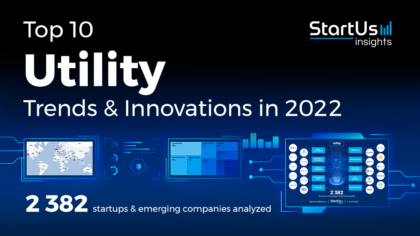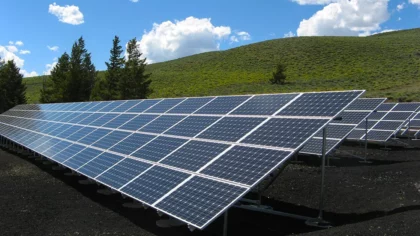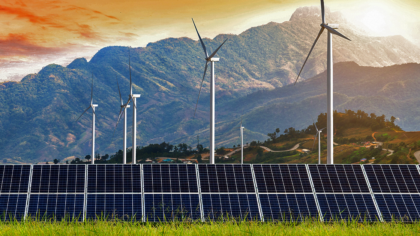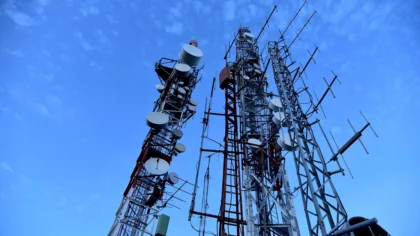Accelerate Productivity in 2025
Reignite Growth Despite the Global Slowdown
Rapidly evolving information and operational technology landscapes are driving digitalization in all industrial sectors. Digital technologies are catalyzing the development of new business and operating models for existing players and new entrants in the utility sector. Emerging utility trends also enable new performance improvements, such as grid resilience, cutting maintenance time and costs with automated asset inspections, and predictive maintenance.
In addition, digitalization powered by the internet of things (IoT) improves the visibility of distributed utility assets, enhancing operations transparency. This further provides opportunities for improvement and facilitates an easy transition into low-carbon utility solutions.
This article was last updated in August 2024.
What are the Top Utilities Industry Trends (2025)?
- Asset Connectivity
- Operational Automation
- Artificial Intelligence
- Decentralized Utility
- Blockchain
- Digital Twin
- Utility Mapping
- Immersive Technology
- Grid Resilience
- Decarbonization
Innovation Map outlines the Top 10 Utility Trends & 20 Promising Startups
For this in-depth research on the Top Utility Industry Trends and startups, we analyzed a sample of 2382 global startups & scaleups. This data-driven research provides innovation intelligence that helps you improve strategic decision-making by giving you an overview of emerging technologies in the energy and utilities industry. In the Utility Innovation Map below, you get a comprehensive overview of the innovation trends & startups that impact your company.
These insights are derived by working with our Big Data & Artificial Intelligence-powered StartUs Insights Discovery Platform, covering 4.7M+ startups & scaleups globally. As the world’s largest resource for data on emerging companies, the SaaS platform enables you to identify relevant technologies and industry trends quickly & exhaustively.
Want to explore all Utility Industry innovations & trends?
Tree Map reveals the Impact of the Top 10 Utility Trends
The Treemap below illustrates the impact of the top 10 utility industry trends in 2025. The increasing pressure on utilities necessitates new infrastructure and its proper maintenance. Technologies like IoT and wireless connectivity networks aid the collection of asset information that improves visibility over the entire utility network.
The improved resilience of the utility grid protects it against adverse weather conditions and malicious cyber attacks. Further, technologies like artificial intelligence, utility mapping, and digital twins improve decision-making. Further, decarbonization solutions enable the transition to cleaner and renewable utility services.
Global Startup Heat Map covers 2382 Utility Startups & Scaleups
The Global Startup Heat Map below highlights the global distribution of the 2300+ exemplary startups & scaleups that we analyzed for this research. Created through the StartUs Insights Discovery Platform, the Heat Map reveals that the US and the UK are leading the innovation in the utility industry.
Below, you get to meet 20 out of these 2382 promising startups & scaleups as well as the solutions they develop. These 20 startups are hand-picked based on criteria such as founding year, location, funding raised, and more. Depending on your specific needs, your top picks might look entirely different.
Top 10 Trends in the Utilities Industry (2025)
1. Asset Connectivity
The proliferation of sensors, connected devices, and big data management practices are enabling the development of smart assets within utility networks. Smart grids comprise a variety of operational and measurement devices including smart meters, smart appliances, and other IoT devices.
These devices allow asset and project managers in the utility industry to gain better visibility into the performance and condition of assets in real time. This enables data-driven decision-making for maintenance schedules, grid capacity monitoring, and service quality improvements.
GridFabric streamlines Load Shifting for Utilities
GridFabric is a US-based startup that creates software for utilities to balance their grid with renewable energy sources like solar and wind. Its Canvas product is an OpenADR server that utilities use to send load-shifting signals, while the Plaid client allows devices to respond to these signals. This improves grid efficiency and benefits all stakeholders. GridFabric’s solutions facilitate the necessary load-shifting communication to address issues caused by the transition to renewable energy.
ELN Sensors and Systems offers Multi-parameter Water Sensors
Indian startup ELN Sensors and Systems designs sensors that measure process parameters like flow, pressure, level, and velocity. ELNEMF, the startup’s electromagnetic flowmeter, measures the flow and level of conductive liquids. ELNBAR, another sensor system, measures multiple parameters, eliminating the need to use multiple measurement instruments. The startup’s multi-parameter water sensors enable non-intrusive measurements in water distribution grids, aiding the detection of water leaks.
2. Operational Automation
The process of utility maintenance and repair involves a huge investment in terms of workforce and safety equipment. Maintenance activities also often involve an enormous amount of risk to worker safety. Innovations in robots, drones, and other autonomous vehicles provide the utility industry with an opportunity to automate a large portion of its daily operations.
These solutions allow operators to work remotely without exposing them to unsafe conditions. Moreover, operational automation frees utility companies from the risk of safety incidents and reduces the cost of maintaining a large number of front-line workers.
Birdstop enables Unmanned Aerial Inspections
US-based startup Birdstop creates a platform for unmanned aerial inspections. The startup’s solution is a nodal infrastructure for the scaled deployment of unmanned aerial vehicles (UAVs) using a remote sensing platform of ground nodes and UAVs. This enables utilities to manage and deploy UAV data collection at distributed assets without personnel onsite. Birdstop’s platform is UAV agnostic and uses data integration and machine learning for precision landing, automated battery management, and dual-layer security.
Noteworthy automates Asset Defect Detection
US-based startup Noteworthy develops a platform that automates asset defect detection for electric utilities. Inspector, the startup’s AI-based solution, uses hardware sensors and AI edge processing arrays mounted on existing fleet vehicles. Inspector Edge comprises all the cameras and other attached hardware devices that run on computer vision models to analyze the captured images.
The Inspector Cloud is the startup’s software that enables rapid review of distribution asset inventories and equipment defects. The startup in this way allows utilities to identify issues faster and shorten the duration of the inspection cycle without additional manpower.
3. Artificial Intelligence
Rapid digitalization provides utilities with a large amount of data that has huge potential in the decision-making process. However, this data is worthless without proper analysis. This is why startups are developing artificial intelligence (AI) technology solutions that recognize data patterns and generate insights. These insights aid utility operators in making decisions like predictive maintenance, demand forecasting, and grid topology optimization.
SCEMAI enables Predictive Maintenance
Portuguese startup Scemai is a Portuguese startup that develops a watchdog system for the analysis, collection, and monitoring of sensor data. The startup creates and configures a sensory network coupled with a smart platform that uses artificial intelligence. The solution analyzes data to enhance the performance of industrial or natural assets and resources.
Improvement in asset data management makes it possible to anticipate maintenance activities. In this way, the solution optimizes processes in the water and energy industries through predictive maintenance.
Etalytics facilitates Demand Forecasting
German startup Etalytics provides energy intelligence solutions that increase energy efficiency and flexibility of utility operations. The startup’s platform and IoT gateways synthesize asset data and deliver AI applications that reduce operational costs and carbon dioxide emissions. Etalytics’ AI platform uses machine learning algorithms to forecast the energy demands of the grid. This allows utilities to optimize energy flow in the grid which enables them to respond to peak loads at an early stage.
4. Decentralized Utility
Many utilities have turned to risk-based predictive asset maintenance and monitoring technologies. However, some utilities continue to rely on traditional scheduled or reactive asset management strategies, that require a large workforce and fail to foresee disruptions. This especially affects the energy utility industry, leading to power gaps and load imbalances.
The availability of decentralized power sources and storage devices and their proper management is necessary to overcome this deficiency. Decentralized utility solutions deliver vital grid services and balance demand with supply to aid utility companies in achieving mission-critical outcomes.
Wenergie provides Decentralized Solar Energy
Indian startup Wenergie develops hardware and software solutions for decentralized solar energy. Nucleus, the startup’s platform, monitors and optimizes the operation of solar panels, battery storage, and connected loads. The platform functions like a motherboard and operating system for energy with plug-in slots for power and communications.
This allows individual consumers to monitor and control the energy consumption of their homes, tweaking the share of solar, grid, and battery usage. This increases the economic sustainability of decentralized solar energy generation and decreases the load on the utility grid.
Hypnetic develops Modular Energy Storage
German startup Hypnetic develops modular energy storage solutions. The startup’s fully scalable energy storage solution uses a proprietary compressed air storage system with high cycle efficiency. Hypnetic’s hydropneumatic energy storage management system (HEMS) controls, regulates and monitors the energy storage in real time.
It continuously optimizes charging and discharging operations to ensure constant energy efficiency and longer service life. The solution specifically aids wind and solar power operators setup generation units in remote locations enabling energy balancing and peak load shavings.
5. Blockchain
The increasing demand for utilities leads to the entry of more players into the utility industry. However, the huge capital investment and environmental restrictions hinder these new utility operators from having sufficient utility resources, making them dependent on larger utility providers. This leads to an enormous number of transactions of utility assets.
The traceability of these transactions is very important to prevent fraud and tampering. Innovations in blockchain technology allow utility owners to trade assets with high transparency and traceability. This enables the easy integration of local utility providers into the grid, decentralizing the supply. The improved traceability also aids in confirming the authenticity of low-carbon claims.
DREX builds a Blockchain-based Solar Portfolio Management Platform
Ecuador-based startup DREX builds a platform that connects investors with solar energy projects in emerging markets. By using IoT and blockchain technologies, it brings automation and transparency to portfolio management. Solar developers raise capital through the platform to install rooftop solar panels on companies.
The installed solar power is tracked in real time using a digital twin utility token. As companies pay their monthly energy bills to a smart contract, the funds are distributed to investors. The platform benefits companies by providing on-site solar power without upfront costs.
The Energy Origin provides Energy Traceability
French startup The Energy Origin provides a blockchain-based platform that turns energy data into secure digital assets. The startup’s platform allows users to choose an energy asset, trace the supply back to its source, and monitor the impact on the environment. This enables the generation of secure audit trails that prove the green consumption with digital certificates that access the consumer’s carbon gains.
6. Digital Twin
Digital twins are in-silico representations of physical assets. For grid operators, digital twins provide the ability to foresee challenges to the grid infrastructure, automate alerts and complex processes, and ensure complete control. Digital twins combine information from different assets in one place, enabling the improvement of operational efficiency. This centralized and visual asset information allows easy utilization of data for maintenance, equipment simulation, reliability models, and IoT-enabled operational integration.
Urbio provides Workflow Digitization
Swiss startup Urbio develops a generative design software that digitizes workflows for utilities and accelerates the transition to clean energy. The startup utilizes GIS and energy data from multiple open and commercial sources to generate a digital twin that generates energy insights.
These insights aid in identifying and visualizing carbon dioxide hotspots, potential building for solar deployment, and quantifying market potentials for utilities. The AI algorithm automates the design of optimized and scalable energy systems from buildings to cities.
Aispeco Systems enables Digital Twins for Power Lines
Lithuanian startup Aispeco Systems enables the simultaneous collection of asset and environmental data for powerline surveys and inspection flights. Its platforms are mounted on various vehicles like SUVs and helicopters. Multiple cameras and LiDAR options offer high-quality aerial mapping of power lines and other linear infrastructure. Utilities use Aispeco’s aerial data collection platforms for digitizing power lines and other corridor assets into accurate 3D digital twins.
7. Utility Mapping
Utility companies need clear maps of their assets to track daily operations as well as recognize opportunities for improvement and expansion. Innovations in geospatial information systems (GIS) transform it into a system of engagement that creates easy access to asset data and the ability to integrate it with asset management systems through the web.
This provides the utility industry with a system for recording geospatial data that is easy to access and share. Utility mapping improves visibility into the distribution network en flexibility of operations and optimizes development plans.
4M Analytics enables Subsurface Utility Mapping
US-based startup 4M Analytics combines remote sensing and artificial intelligence for subsurface utility mapping. The startup uses natural language processing (NLP) methods to scan numerous data sources including satellite imagery, social media records, and local databases. It processes this data to generate a utility map with both on-surface and subsurface layers.
These maps provide electric, telecom, and gas utilities with visibility over assets at every stage of the project lifecycle. This enables them to avoid unexpected costs, schedule delays, infrastructure damage, and safety incidents.
ENER-i’s maximizes Utility Information Utilization
US-based startup ENER-i develops a cloud-based software-as-a-service platform that aids the planning and operations in the energy industry. GIS Core is the startup’s ESRI-based map modeling software that serves as an asset search engine and allows multi-map management.
ENER-i also provides planning and operations modules that maximize the utilization of utility information by integrating asset management with advanced planning strategies. This solves energy issues including DER optimization, EV fleet adoption, and mobility electrification.
8. Immersive Technology
Although moving towards automation, the utility industry still requires a workforce to carry out operational activities that are too complex to automate. Startups are developing solutions for safe and proper training and guidance of operators in maintenance and repair activities.
Based on immersive technologies like augmented reality (AR) and virtual reality (VR), startups are creating smart glasses, helmets, and other wearable devices suitable for utility applications. These devices aid workers in asset inspection and maintenance, work instructions, training, workflow management, operations, and safety. Further, they allow the workers to collaborate remotely with their supervisors.
Kampov Technology offers Immersive Worker Training
Ukrainian startup Kampov Technology develops AR and VR solutions for education and enterprise use cases. The startup training simulators allow new hires in utility companies to perform maintenance and repair activities. These simulators allow utility companies to train front-line workers on critical operations without exposure to dangerous equipment and conditions.
Augmenteed provides Utility Repair Guidance
Singaporean startup Augmenteed builds an AR-based process management software that replaces manual processes and provides workers access to critical information at their job sites. The startup’s platform uses a proprietary standard operating procedures (SOP) app builder that allows industrials to digitize their workflows without coding.
This allows companies to digitize workflows, and optimize and automate processes that allow the integration of AR technology. The AR aspect allows efficient training of technicians and guides them in real-time with remote experts. This allows utility companies to give step-by-step instructions for procedures, avoiding errors and improving productivity.
9. Grid Resilience
The risk of damages to assets either as a result of environmental conditions or malicious activities is difficult to monitor due to the vastness of utility infrastructure. To maintain the uninterrupted delivery of utilities to consumers, the utility industry is developing robust and resilient grid solutions.
Such solutions allow the utility grid operators to quickly resume normal operations in the aftermath of damage anywhere in the grid. Vegetation management is a significant approach in this innovation that allows grid owners to avoid damage due to fires improving the grid’s resilience. Apart from the physical threats, the increased digitization makes the grid vulnerable to cyber attacks.
Overstory offers a Vegetation Management Platform
Dutch startup Overstory provides a vegetation management platform that improves the resilience of utility grids. The startup’s software solution uses machine learning to interpret satellite images and climate data to extract detailed data about trees and shrubs around utility assets.
Combining this data with diverse spatial, spectral, and temporal resolution provides real-time and predictive insights into the risk posed by vegetation. This pinpoints grow-in and fall-in risks, recommending trimming plans and estimating future trimming requirements. The startup’s solution, thus, prevents abrupt power interruptions and reduces maintenance costs for electric utilities.
SecureCo advances Network Cybersecurity
US-based startup SecureCo develops cybersecurity solutions for IoT and telecom networks. The startup’s patent-pending technology employs a zero-trust mesh network tunnel that possesses self-healing capabilities and anonymizing, deceptive, and fortifying attributes.
For telecom companies, the startup’s technology offers cybersecurity solutions for both terrestrial and satellite networks. SecureCo’s solution for energy utilities protects data transactions and the integrity of the numerous IoT devices critical to operations. SecureCo’s solution prevents threats to business continuity from malicious attacks.
10. Decarbonization
The utility industry needs to evolve its transmission capabilities across the grid in order to meet the carbon reduction goals of regulators, investors, and customers. Utility companies will look to upsize their transmission and distribution spending programs to accommodate the expansion of EVs, distributed energy resources (such as solar and battery storage), smart home devices, and other key technologies.
This is not only for residential customers but also for those in the commercial and industrial domains. Innovations in this domain of renewable transition lead to the development of platform solutions that are able to easily integrate new low-carbon technologies into existing infrastructure. This allows utility companies to abide by decarbonization requirements without exorbitant capital expenditures.
Ethernetics advances Telecom Decarbonization
Belgian startup Ethernetics develops and implements decarbonization solutions that lower the carbon footprint of data centers, data center customers, and telco providers. The startup’s decarbonization platform distributes, measures, monitors, and controls all the power requirements in data centers and smart telecom-grade buildings.
The solution keeps track of the performance of the infrastructure which enables predictive maintenance of individual devices and the whole infrastructure. This allows telecom companies to optimize their capacity and minimizes urgent interventions. Further, it enables telecom utilities to reduce energy consumption and discard any unwanted resources, achieving lower carbon footprints.
Bamboo Energy accelerates Distributed Energy
Spanish startup Bamboo Energy develops a platform for a distributed energy platform. It enables energy retailers and aggregators to efficiently manage distributed flexibility resources. The startup’s platform forecasts consumption, flexibility, and energy market conditions for optimal portfolio management.
The platform allows personalized and tailored solutions to manage all DERs and flexibility assets. This reduces the operating costs of decentralized renewable power generators, making them economically viable and accelerating the transition to renewables, thereby reducing the carbon footprint.
Discover all Utility Trends, Technologies & Startups
Innovations in the utility industry improve the operational efficiency of distribution networks and provide consumers with safe, affordable, and reliable services. New techniques, devices, and connectivity tools ensure all assets operate at maximum efficiency. Demand-side management, decarbonization platforms, and immutable blockchain-based records enable the adoption of low-carbon alternatives and ensure the authenticity of carbon gains.
The Top Utility Trends and startups outlined in this report only scratch the surface of trends that we identified during our data-driven innovation & startup scouting process. Identifying new opportunities & emerging technologies to implement into your business goes a long way in gaining a competitive advantage.



 WATCH THE VIDEO VERSION
WATCH THE VIDEO VERSION 



![Dive into the Top 10 Utilities Industry Trends & Innovations [2025]](https://www.startus-insights.com/wp-content/uploads/2025/04/Utilities-Industry-Trends-SharedImg-StartUs-Insights-noresize-420x236.webp)
![Dive into the Top 10 Water Management Trends & Innovations [2025]](https://www.startus-insights.com/wp-content/uploads/2025/04/Water-Management-Trends-SharedImg-StartUs-Insights-noresize-420x236.webp)



